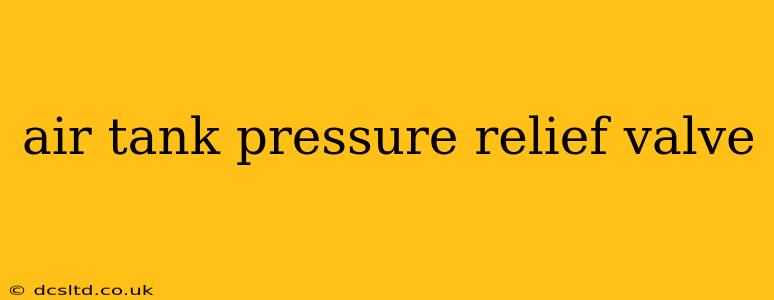Air tank pressure relief valves are critical safety devices designed to protect air tanks and surrounding equipment from overpressurization. Understanding their function, types, and maintenance is crucial for safe and efficient operation in any application utilizing compressed air. This comprehensive guide will delve into the intricacies of air tank pressure relief valves, answering common questions and providing essential information for both professionals and enthusiasts.
What is an Air Tank Pressure Relief Valve?
An air tank pressure relief valve, also known as a pressure relief valve (PRV), safety valve, or pressure release valve, is a safety mechanism installed on compressed air tanks. Its primary function is to automatically release excess pressure from the tank should the pressure exceed a pre-set limit. This prevents catastrophic tank rupture, potential injury, and property damage. These valves are essential for maintaining safe operating conditions and complying with industry safety regulations.
How Does an Air Tank Pressure Relief Valve Work?
The operation is fairly straightforward. The valve incorporates a spring-loaded mechanism. As the pressure inside the tank increases, it pushes against a spring-loaded disc or piston. When the pressure reaches the predetermined set point, the force overcomes the spring tension, opening the valve and releasing compressed air until the pressure drops below the set point, at which point the valve closes automatically. The design ensures a rapid and effective release of excess pressure, preventing dangerous over-pressurization.
What are the Different Types of Air Tank Pressure Relief Valves?
Several types of air tank pressure relief valves exist, each with specific design features and applications. Common types include:
- Spring-loaded valves: The most common type, utilizing a spring to control the pressure release point. These are relatively simple, reliable, and cost-effective.
- Pilot-operated valves: These valves use a pilot signal to control the opening and closing of the main valve. They offer more precise pressure control and are often used in more complex systems.
- Temperature-compensated valves: Designed to account for changes in ambient temperature, which can affect the spring tension and the valve's set pressure. These are particularly useful in environments with fluctuating temperatures.
- Rupture discs: While not strictly a valve, rupture discs serve a similar safety function. They are designed to burst at a specific pressure, releasing the compressed air. They are typically used as a final safety measure, offering a simpler, less maintainable, and single-use solution.
How Often Should I Inspect My Air Tank Pressure Relief Valve?
Regular inspection is crucial for maintaining safety and ensuring the valve functions correctly. The frequency of inspection depends on the application and local regulations but should at least be included in your routine maintenance checks. Look for signs of damage, corrosion, leaks, or any indications that the valve isn't operating smoothly. A qualified technician should perform regular testing and recalibration.
What are the Signs of a Failing Air Tank Pressure Relief Valve?
Several signs may indicate a problem with your pressure relief valve:
- Valve leaks: A small leak might indicate a failing seal or other internal damage.
- Valve doesn't open: If the pressure in the tank exceeds the set point and the valve doesn't relieve the pressure, this is a serious issue and requires immediate attention.
- Valve sticks open: This indicates a potential problem with the spring mechanism or internal components.
- Corrosion or damage: Visible damage, rust, or corrosion can compromise the valve's integrity and function.
How Do I Choose the Right Air Tank Pressure Relief Valve for My Application?
Selecting the correct valve is vital for safety and efficiency. Factors to consider include:
- Tank pressure: The maximum operating pressure of your air tank dictates the required valve's set pressure.
- Airflow capacity: The valve's capacity to release compressed air must be sufficient for the size and type of your tank.
- Environmental conditions: Temperature, humidity, and potential corrosive elements can affect the valve's performance and lifespan.
- Safety regulations: Comply with all relevant industry safety standards and regulations when choosing and installing your pressure relief valve.
Can I Repair an Air Tank Pressure Relief Valve Myself?
Repairing a pressure relief valve is generally not recommended for non-professionals. These valves are safety-critical components, and improper repair can compromise safety. It's always best to replace a damaged or malfunctioning valve with a new one from a reputable supplier. Consult a qualified technician for any issues or uncertainties.
This guide provides a comprehensive overview of air tank pressure relief valves. Always prioritize safety when dealing with compressed air systems and remember that regular maintenance and inspection are key to preventing accidents and ensuring the longevity of your equipment. Remember to consult relevant safety regulations and seek professional help when necessary.
